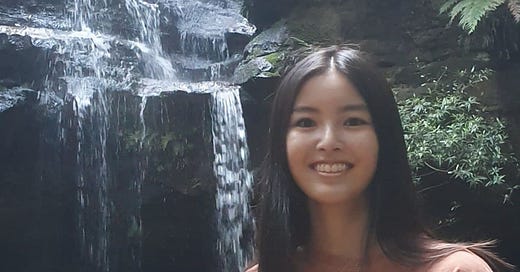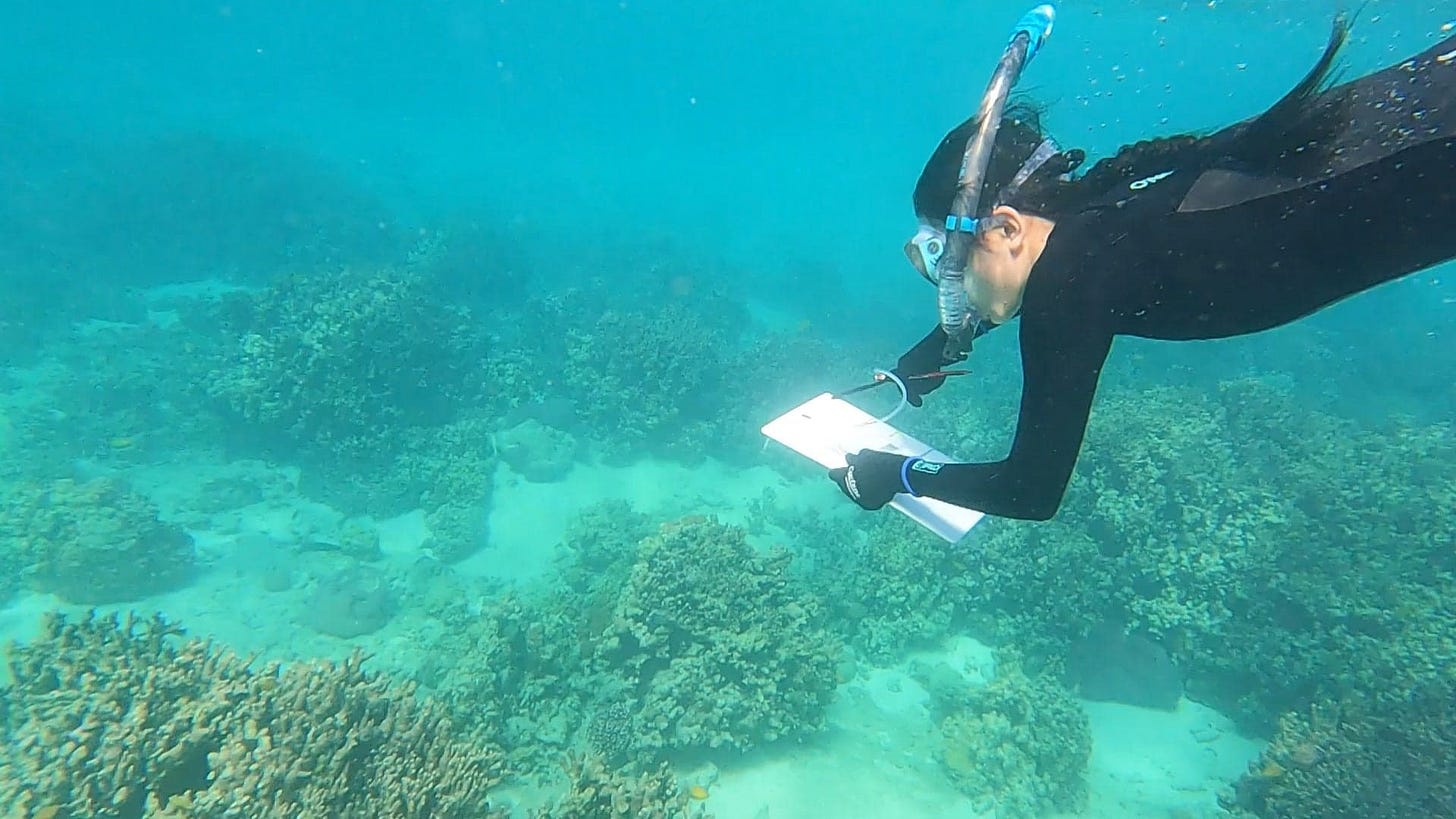How Aileen Found Her Passion and Motivation for Marine Science
To choose a university course and career path you love, try your options out for yourself.
“I would recommend wildlife conservation and/or marine science to anyone who loves animals, loves the environment and wants a career in science that’ll make a positive impact on the planet.”
Aileen Tan
Aileen Tan’s family expected her to study business at university and have a career in finance. “A lot of people in my family, including all my close cousins, have gone down this path before me,” she says. Her HSC subjects included English Advanced, Maths Advanced, Chemistry, Science Extension, Economics and Studies of Religion (2U). She chose Economics at her cousins’ behest, but found she enjoyed it.
When Aileen graduated, she enrolled in university and made finance her major. But she soon found that she didn’t enjoy the finance units at all. The classes dragged and her motivation fell. “It was clear finance was not for me,” she says.
The days of high school graduates stepping smoothly into a single career path that defines their professional life ended decades ago, but they cast a long shadow. Students, families and schools alike describe the challenge of ‘knowing what you want to do,’ as if describing a destination rather than a journey. Even students enrolling in generalist degree programs, such as arts or commerce, are asked about their intended career, singular. It’s not just a projection by Gen X parents. As career options multiply in number and complexity, students experience more uncertainty than ever - it’s no wonder if they sometimes boil all the countless options down into a single imagined path.
Aileen was already hedging her options. Alongside finance, she opted for a second major in wildlife conservation. “I’ve always loved animals and the ocean,” she says. “And I find the Great Barrier Reef fascinating.”
How do students choose what to study?
Students can face stressful or confusing crosscurrents of formal and informal career advice. Research shows teachers shape students’ feelings about their subjects: how interesting they are, how useful they are, and how successful the student expects to be in future.1 Schools offer seminars or consultations with careers advisers, whose resources can vary dramatically. Friendship groups exert peer pressure to select a future from a narrow set of popular options. Families offer early exposure to a handful of occupations - as well as expectations about what careers would elicit family pride. All groups bring their biases. Most favour past trends and financial stability.
Yet students themselves tend to look for courses that align with their interests and perceived abilities, rather than ones that maximise future income.2
You might wish for someone to draw a nice, simple flowchart to visualise all these complex factors in a way that is easy to understand. Unfortunately, with so many variables in play, our best resource is the Eccles Expectancy-Value Model:

It may take a minute to digest, but it shows a few things really well:
Cultural milieu: The first box shows how all decisions are made against a backdrop of social forces, including demographics and stereotypes.
Success spurs motivation: The “Expectation of Success” and “Subjective Task Value” boxes on the right are shown to be mutually reinforcing: we value things more if we expect to succeed at them, and we expect to succeed more at things we value.
Choices accumulate: The final outputs - our choices and performance - feed right back into the start of the process, showing how each experience shapes our future choices.
It may often feel that all these factors are outside a student’s control. Confidence and motivation, or what researchers call “ability self-concept,” can predict learning outcomes, career aspirations, subject and university course choices.3 If you are in maths class, one of the best guides to your expectations of success in that subject is the way in which you compare yourself to the rest of your class or cohort. Researchers find that “equally able students develop different ability self-concepts depending on whether they are in a higher achieving or lower achieving peer group.” They call it the big-fish-little-pond effect (BFLPE). Smarter peers can make you feel less smart by comparison - a potential drawback of streamed classes.
The BFLPE has been found to impact motivation, although not necessarily to predict university course choices. Marks, motivation (“subjective task value”) and confidence (“ability self concept”) in maths do predict a greater likelihood of selecting a STEM major.4 A more recent study, based on two longitudinal data sets of German students, suggests that students pay greater attention to their own relative ability across all their subjects than to their peers' performance within those subjects.5 In other words, what matters is whether English or Maths is your own top subject, not whether you are first or last in that particular class.
Yet almost all of the factors above are within students’ control to a greater extent than they often realise. Our goals, self-belief, enjoyment and confidence with particular subjects or careers are all shaped by the quality of our experiences of giving those careers a try. Rather than rely on the advice around them, students should seek out career-related experiences to see how the advice stacks up for themselves.
For students who start courses or jobs and road test a career for the first time, the first try is rarely a perfect match. Aileen worked at an accounting firm for a few months. “I realised I didn’t want to be sitting down all day,” she reflects. The adjustment, whether minor or major, towards a better fit, can stir confusing emotions of worry, shame or relief, as a change of path can also mean a change of purpose and even identity.
One study, published in January 2018, conducted focus groups with women regarding their career choices. Gina, a mother working in a non-STEM career, while initially having both STEM aspirations and a STEM career, described some pros and cons:
“Before kids certainly having a math degree and being able to go into the financial industry was very lucrative, which was great. I think the cons of it [were that] there was a lot of travel [involved]. There were a lot of demanding hours. You got pampered too. They took good care of you, good benefits, etcetera. But again, it’s very demanding and it’s very cutthroat. [In] the financial industry there are a lot of layoffs even now. That’s something that you had to worry about. Post kids with my coaching and consulting the pros are [that] it’s very flexible.”6
The study identifies family commitments, as well as teachers (primary, secondary and tertiary) and personal values and interests as key themes in the focus groups. It also notes that girls generally have lower self-belief for mathematics than boys (even when their ‘objective’ achievements are the same) and tend to find maths less interesting or valuable.7
Aileen was a highly capable mathematician, but her decision was based on more holistic factors. “I thought a career that would allow me to help the environment would be more rewarding for me than something in finance,” she says. “Wildlife conservation and marine science seemed like majors that complimented each other well.” She made the switch, abandoning finance in favour of a full science degree.
To Aileen’s parents, this looked like a mistake. “In their eyes it was not as prestigious, and I would make less money in the future,” Aileen explains. But science had long been among her strengths, and she had studied Science Extension in her HSC instead of other extension subjects because she was interested in scientific research, and thought she might want to pursue it at university.
Aileen’s choices were also atypical in the highly gendered world of HSC subject selection. Course enrolment data for 2022 show that girls in NSW remain a minority for most high school STEM subjects, except Biology, while Mathematics Advanced and Chemistry are approaching gender parity.8
Mathematics Standard 1: 2,954 males (58%) vs 2,140 females (42%)
Mathematics Standard 2: 14,593 males (48%) vs 16,020 females (52%)
Mathematics Advanced: 9,002 males (53%) vs 8,143 females (47%)
Mathematics Extension 1: 5,288 males (59%) vs 3,619 females (41%)
Mathematics Extension 2: 2,176 males (66%) vs 1,117 females (34%)
Biology: 6,802 males (35%) vs 12,371 females (65%)
Chemistry: 5,235 males (52%) vs 4,836 females (48%)
Physics: 6,047 males (78%) vs 1,683 females (22%)
Science Extension: 259 males (38%) vs 422 females (62%)
Economics: 3,609 males (66%) vs 1,839 females (34%)
Engineering Studies: 2,116 males (89%) vs 265 females (11%)
Industrial Technology: 4,783 males (83%) vs 965 females (17%)
Information Processes and Technology: 1,497 males (81%) vs 362 females (19%)
Software Design and Development: 1,633 males (88%) vs 216 females (12%)
Many of these ratios have been unchanged for decades. The highest level maths subject, Mathematics Extension 2, was 66% male in 2022, just as it was in 1998.9
Aileen’s decision to double down on her love for science had a profound effect. The combination of wildlife conservation and marine science opened a world of discoveries. “I love being able to study all the interactions between different environmental systems, habitats, and the biodiversity within them,” she says.
There is no substitute for having a go
Finding a passion or disinterest in a field is hard to do from a distance. Not only is doing better than watching, but many aspects of a job can also hide under the surface. Psychology students, fascinated by the human mind or eager to help vulnerable patients, are sometimes surprised to encounter research methods and statistics in their first year at university.
Aileen encountered surprises, too. “I was surprised that I would need to learn coding skills for most of the statistics,” she admits. But rather than feeling daunted, she felt energised. It struck her how useful and powerful a tool the coding could be. The link between her programming skills and insights that her research could yield was clear and motivating. Her enjoyment of the field only grew. She wouldn’t be sitting down and writing code all day, either. “I like that related careers will likely have a mix of working in an office or lab as well as being outside doing fieldwork, which I enjoy.”
Now in her fourth year at the University of Sydney, Aileen feels like she has begun a genuinely promising career. “The degree allows me to pursue a career in research, in industry, environmental/wildlife management and much more,” she says. Over time, her parents have adjusted to her new direction, too. “They’re more accepting of it now after seeing that I am putting more effort into my studies, and I’m more enthusiastic about learning instead of just going through the motions to make it through each semester.”
I asked Aileen what lessons her journey might have for others. “Studying something you love and are passionate about is a lot more rewarding and I’ve been more enthusiastic about my studies,” she says. “There are still ups and downs, but I’m definitely more motivated to work through things compared to before. You’ll likely find that what motivates you isn’t just the stress of needing to get things done but also a personal drive that makes you want to go above and beyond.”
Meeta Banerjee, Katerina Schenke, Arena Lam and Jacquelynne Eccles. (2018). “The role of teachers, classroom experiences, and finding balance: Perspective on the experiences and expectations of females within STEM and non-STEM careers.” pp 296.
Smith Family, “On Track? Students Choosing a Career,” 2006
Luise von Keyserlingk, Anna-Lena Dick, Michael Becker and Jacquelynne Eccles. “What Matters When? Social and Dimensional Comparisons in the Context of University Major Choice.” AERA Open January-December 2021, Vol 7, No 1. pp 2.
“What Matters When?” pp 3.
“What Matters When?” pp 8.
“The role of teachers, classroom experience, and finding balance,” pp 294-5.
“The role of teachers, classroom experience, and finding balance,” 288-289
Pallavi Singhal, 'Concerning': HSC gender trends have not changed over 20 years, Sydney Morning Herald, 15 October 2018.





